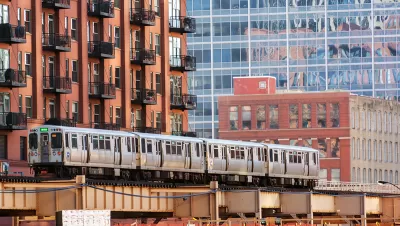As Chicago's population slowly dwindles, Yonah Freemark argues that the city needs to take advantage of one of its greatest assets: its transit network. Housing for residents of all incomes near transit stops may be the key.

Chicago is caught in a paradox: the city's overall population is stagnant. And yet, the city is gentrifying.
By most accounts, Chicago remains an attractive, vibrant city. So much so that wealthier residents are snatching up rental properties, and driving up rents, while displacing some of the city's poorer residents. The result is not only a less egalitarian city, but also one that fails to capitalize on the city's extensive, fully built-out transit network. That's the analysis of Yonah Freemark, a project manager with Chicago's Metropolitan Planning Council.
While Chicago may seem like the ultimate in transit-oriented cities—a large percentage of the city's residences and even larger percentage of its employment centers are within a mile radius of transit—Freemark contends that higher-income residents do not use transit as much as their less wealthy counterparts. They also live at lower densities. Thus, Chicago may be cannibalizing itself.
"[W]hy are Chicago’s vibrant, transit-oriented communities that are attracting people still losing population? People who want to live in these areas but cannot afford high-price homes instead often choose to move to new suburban communities, which results in more traffic congestion and higher transportation costs, not to mention encouraging construction on previously undeveloped land," writes Freemark.
This problem, though, is not just one of economics. It's also one of policy.
"One of the primary reasons why homes and apartments in many of Chicago’s neighborhoods are so expensive, and why population has declined, is that zoning has limited the construction of new housing," writes Freemark. Freemark lauds the city's 2013 transit oriented development ordinance but contends that much more remains to be done until Chicago successfully marries its 20th century infrastructure with 21st century urban trends.
FULL STORY: Why should Chicago focus growth near transit?

Alabama: Trump Terminates Settlements for Black Communities Harmed By Raw Sewage
Trump deemed the landmark civil rights agreement “illegal DEI and environmental justice policy.”

Planetizen Federal Action Tracker
A weekly monitor of how Trump’s orders and actions are impacting planners and planning in America.

The 120 Year Old Tiny Home Villages That Sheltered San Francisco’s Earthquake Refugees
More than a century ago, San Francisco mobilized to house thousands of residents displaced by the 1906 earthquake. Could their strategy offer a model for the present?

In Both Crashes and Crime, Public Transportation is Far Safer than Driving
Contrary to popular assumptions, public transportation has far lower crash and crime rates than automobile travel. For safer communities, improve and encourage transit travel.

Report: Zoning Reforms Should Complement Nashville’s Ambitious Transit Plan
Without reform, restrictive zoning codes will limit the impact of the city’s planned transit expansion and could exclude some of the residents who depend on transit the most.

Judge Orders Release of Frozen IRA, IIJA Funding
The decision is a victory for environmental groups who charged that freezing funds for critical infrastructure and disaster response programs caused “real and irreparable harm” to communities.
Urban Design for Planners 1: Software Tools
This six-course series explores essential urban design concepts using open source software and equips planners with the tools they need to participate fully in the urban design process.
Planning for Universal Design
Learn the tools for implementing Universal Design in planning regulations.
Clanton & Associates, Inc.
Jessamine County Fiscal Court
Institute for Housing and Urban Development Studies (IHS)
City of Grandview
Harvard GSD Executive Education
Toledo-Lucas County Plan Commissions
Salt Lake City
NYU Wagner Graduate School of Public Service





























